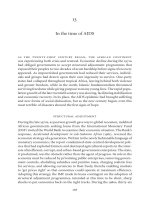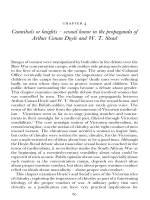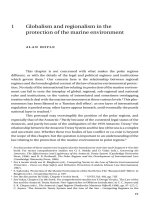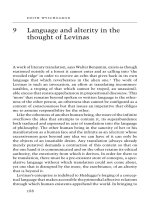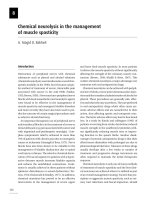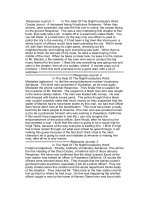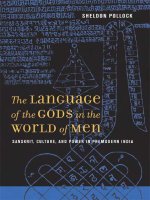Chinas rise in the diamond market an international explanation for the resurgence of conflict diamonds
Bạn đang xem bản rút gọn của tài liệu. Xem và tải ngay bản đầy đủ của tài liệu tại đây (3.93 MB, 125 trang )
CHINA’S
RISE
IN
THE
DIAMOND
MARKET:
AN
INTERNATIONAL
EXPLANATION
FOR
THE
RESURGENCE
OF
CONFLICT
DIAMONDS
GILLES
PHILIPPE
DAMIEN
MARIE
(M.Soc.Sci)
A
THESIS
SUBMITTED
FOR
THE
DEGREE
OF
MASTER
OF
POLITICAL
SCIENCE
DEPARTMENT
OF
POLITICAL
SCIENCE
NATIONAL
UNIVERSITY
OF
SINGAPORE
2011
Acknowledgements
I
wish
to
thank
Dr.
Luke
David
O’Sullivan
for
providing
thoughtful
and
invaluable
comments
to
this
thesis.
I
am
eternally
grateful
to
the
interest
that
he
took
in
this
project
and
the
constructive
analysis
he
has
made.
His
professionalism
is
commendable
and
I
shall
never
forget
the
words
of
encouragement
provided.
Similarly,
I
would
like
to
thank
Dr.
Lin
Kun
Chin
for
his
support
at
the
initial
phase
of
the
thesis
and
for
the
help
he
gave
whenever
I
needed
clarifications
about
the
topic.
I
would
also
like
to
thank
the
NUS
professors
who
have
mentored
and
advised
me
during
these
two
years
spent
as
a
Masters
Student.
I
also
thank
my
friends,
Mr.
Paul
Culligan
and
Mr.
Jonathan
Yeo,
for
being
my
sounding
board
and
for
discussing
many
issues
that
have
helped
me
make
important
decisions
regarding
this
paper.
Their
patience
and
interesting
views
of
the
world
have
been
a
breath
of
fresh
air.
Most
importantly,
I
would
like
to
thank
my
parents
Joe
and
Suzy,
and
my
two
sisters
Delphine
and
Sarah
for
the
endless
support
provided.
Thank
you
for
believing
in
me
and
for
being
here
through
the
ups
and
downs.
1
Table
of
Contents
SUMMARY .......................................................................................................................................... 3
LIST
OF
TABLES ............................................................................................................................... 4
LIST
OF
FIGURES.............................................................................................................................. 5
LIST
OF
ABBREVIATIONS.............................................................................................................. 6
CHAPTER
1:
INTRODUCTION ...................................................................................................... 8
CHAPTER
2:
CHINA,
AFRICA
AND
THE
DIAMOND
LINK................................................... 16
REDEFINING
CHINA’S
INVOLVEMENT
IN
AFRICA ............................................................................................. 16
WHY
THE
GLOBAL
PRODUCTION
NETWORK
FRAMEWORK?.......................................................................... 17
CHINESE
INVESTMENT
STRATEGIES
IN
AFRICA ................................................................................................ 21
UNDERNEATH
THE
BIG
PROJECTS ..................................................................................................................... 29
WHY
DOES
CHINA
WANT
DIAMONDS? ............................................................................................................ 30
WHY
CHINA
HAS
CHANGED
ITS
BEHAVIOUR
IN
THE
DIAMOND
MARKET ...................................................... 36
CHAPTER
3:
BLOOD
DIAMONDS.............................................................................................. 40
THE
CAUSAL
LINKS
BETWEEN
CIVIL
WARS
AND
CONFLICT
DIAMONDS ............................................................ 43
CONTEXTUALISING
THE
ISSUE:
TOWARDS
AN
INTERNATIONAL
FRAMEWORK
TO
EXPLAIN
RESOURCE-‐
MOTIVATED
CONFLICTS .................................................................................................................................... 51
THE
MAIN
ASSUMPTIONS
AND
THEIR
AIMS...................................................................................................... 55
CHAPTER
4:
INTERNAL
CAUSES
OF
CONFLICT
IN
DIAMOND-RICH
COUNTRIES ..... 58
INTERNAL
CAUSES
OF
CIVIL
WARS
IN
RESOURCE-‐RICH
COUNTRIES ................................................................. 60
THE
CAUSES
OF
CONFLICT
IN
THE
DEMOCRATIC
REPUBLIC
OF
CONGO,
IVORY
COAST
AND
ZIMBABWE .... 62
CONCLUSION ..................................................................................................................................................... 79
CHAPTER
5:
REGIONAL
AND
INTERNATIONAL
FACTORS............................................... 80
DEFINING
ILLEGAL
MARKETS ............................................................................................................................. 83
AFRICA’S
POROUS
BORDERS
AND
FAILING
POLICIES ........................................................................................ 87
FACTS
AND
NUMBERS
DON’T
LIE...................................................................................................................... 89
THE
IMPACT
OF
THE
NEW
MARKET
LEADERS
ON
THE
RESURGENCE
OF
CONFLICT
DIAMONDS...................... 99
CONCLUSION ...................................................................................................................................................105
CHAPTER
6:
CONCLUSION .......................................................................................................107
IMPLICATIONS
FOR
THE
KIMBERLEY
PROCESS ...............................................................................................108
FUTURE
AVENUES
OF
RESEARCH.....................................................................................................................111
BIBLIOGRAPHY ...........................................................................................................................112
APPENDICES.................................................................................................................................122
2
Summary
This
paper
offers
an
international
explanation
of
the
civil
wars,
ongoing
conflicts,
and
other
forms
of
political
strife
occurring
in
those
African
countries
where
most
of
the
world’s
diamonds
are
mined.
Specifically,
it
argues
that
China’s
emergence
as
the
second
largest
world
market
for
diamonds
after
the
United
States
has
adversely
affected
the
diamond
industry
and
been
responsible
for
the
resurgence
of
the
‘blood
diamond’
phenomenon.
After
reviewing
China’s
investment
behaviour
in
Africa,
I
conduct
a
historical
reconstruction
of
contemporary
scholarship
on
the
causes
of
political
instability,
including
civil
war.
The
latter
consist
of
three
frameworks
–
psychological
(greed
and
grievance),
lootability
(geological
factors)
and
revenue
frameworks
(government
capacity)
–
to
explain
why
conflicts
occur
in
diamond
rich
countries.
Following
that,
I
show
how,
one
should
also
address
transnational
factors
such
as
diamond
smuggling
in
Africa,
and
international
factors,
particularly
the
major
shift
in
the
world
market
for
diamonds
that
China’s
increasing
demand
has
created,
thus
turning
the
presence
of
diamonds
in
Africa
into
a
resource
curse.
After
careful
analysis
and
advice
provided
by
those
who
reviewed
this
study
I
would
like
to
state
that
civil
wars
are
the
worst
possible
outcome
that
occurs
when
there
are
political
problems
in
countries
and
before
it
happens,
there
are
certain
stages
that
states
face
which
is
an
important
part
of
this
paper.
3
List
of
Tables
Table
2.1:
Chinese
Institutions
with
Involvement
in
Africa…………………………..……….
25
Table
2.2:
Trade
and
Economic
Cooperation
Zones
in
Africa
approved
by
the
Chinese
Ministry
of
Commerce……………………………………………………………………..………
28
Table
3.1:
The
Different
Types
of
Conflicts
that
occur
due
to
Geological
Distribution
of
Resources…………………………………………………………………………………..….
45
Table
3.2:
Revenue
Opportunity
Structure
and
the
Risk
of
State
Collapse………..……
48
Table
5.1:
Diamond
Production,
Import
and
Export
by
Ghana
and
Guinea…………….
95
Table
5.2:
Production,
Import
and
Export
of
Diamonds
by
China
and
India…………
103
4
List
of
Figures
Figure
4.1:
The
Democratic
Republic
of
Congo……………………………………………………….
67
Figure
4.2:
Ivory
Coast……………………………………………………….…………………………………..
77
Figure
5:
Procedures
of
diamond
processing
trade
through
SDE
Customs…….……….
83
Figure
5.1:
The
Smuggling
Route………………………………………………………………………90
5
List
of
Abbreviations
ACR
-‐
Africa
Consolidated
Resources
PARECO
-‐
Coalition
of
Congolese
Patriotic
Resistance
FARDC
-‐
Congolese
Armed
Forces
CABC
–
China
Africa
Business
Council
CADF
–
China-‐Africa
Development
Fund
CDB
–
China
Development
Bank
CIC
–
China
Investment
Corporation
CNDP
-‐
Congress
for
the
Defense
of
the
People
CNPC
–
China
National
Petroleum
Corporation
DRC
-‐
Democratic
Republic
of
Congo
DAC
-‐
Diamond
Administration
of
China
DTC
-‐
Diamond
Trading
Company
GRPIE
-‐
Extractive
Industries
Advocacy
Research
Group
GPA
-‐
Global
Political
Agreement
GPN
-‐
Global
Production
Network
HRD
-‐
Hoge
Raad
voor
Diamant
HRW
-‐
Human
Rights
Watch
FDLR
-‐
Democratic
Forces
for
the
Liberation
of
Rwanda
DDC
-‐
Diamond
Dealers
Club
ELF
–
Ethno-‐Linguistic
Fractionalisation
FOCAC
-‐
Forum
on
China
Africa
Cooperation
IRIN
-‐
Integrated
Regional
Information
Networks
JOC
-‐
Joint
Operational
Command
6
KP
-‐
Kimberley
Process
KPCS
-‐
Kimberley
Process
Certification
System
MDC
-‐
Movement
for
Democratic
Change
MIBA
-‐
Miniere
de
Bakwange
MDGs
-‐
Millennium
Development
Goals
NDRC
–
National
Development
and
Reform
Commission
UNITA
-‐
National
Union
for
the
Total
Independence
of
Angola
(União
Nacional
para
a
Independência
Total
de
Angola)
NF
–
New
Forces
(Forces
Nouvelles)
NGOs
-‐
Non-‐Governmental
Organizations
ODI
-‐
Overseas
Direct
Investment
APCLS
-‐
Patriotic
Alliance
for
a
Free
and
Sovereign
Congo
ROC
-‐
Republic
of
Congo
RUF
-‐
Revolutionary
United
Front
SDE
-‐
Shanghai
Diamond
Exchange
SEZs
-‐
Special
Economic
Zones
SRDS
-‐
Surat
Rough
Diamond
Sourcing
Limited
U.N.
-‐
United
Nations
WDC
-‐
World
Diamond
Council
ZMDC
-‐
Zimbabwe
Mining
Development
Corporation
7
Chapter
1:
Introduction
On
November
26,
2010,
two
reporters
from
Bloomberg
were
brutalised
by
a
group
of
diamond
dealers
in
Manica,
Mozambique
because
they
were
investigating
how
trading
towns
like
Manica
and
others
around
Africa
were
keeping
the
scourge
of
blood
diamonds
alive.
Mozambique
is
not
an
official
diamond
producer
and
yet
traders
from
all
over
the
world
flock
there
to
acquire
the
diamonds
that
are
being
illegally
exported
from
the
diamond
mines
of
Chiadzwa
and
Marange
in
neighbouring
Zimbabwe.
These
illegal
mines
are
tainting
the
diamond
industry
as
the
gems
are
mined
by
forced
labour
under
inhumane
conditions
and
proceeds
from
the
sales
are
used
to
finance
the
cronies
in
the
government.1
These
smuggled
diamonds
eventually
find
their
way
into
the
legal
diamond
pipeline
and
most
of
them
end
up
on
brides
as
a
symbol
of
love.
The
issue
of
conflict
diamonds
has
plagued
the
industry
since
the
early-‐1980s
when
the
rebels
of
the
National
Union
for
the
Total
Independence
of
Angola
(UNITA)
were
found
using
diamonds
to
finance
their
war
effort
in
the
Angolan
Civil
War.2
It
became
a
global
issue
when
the
U.N.
and
other
NGOs
decided
to
take
action
as
the
phenomenon
spread
to
other
parts
of
Africa
like
Sierra
Leone.3
Back
then,
most
of
the
stones
were
mined
and
sent
to
the
polishing
factories
of
Antwerp
1
Brian
Latham
and
Fred
Katerere,
“Smuggled-‐Diamond
Revenue
Flows
to
Mugabe's
Zimbabwe
Before
Vote,”
Bloomberg,
December
29,
2010,
accessed
December
29,
2010,
/>s-‐zimbabwe-‐ahead-‐of-‐2011-‐election.html.
2
Conflict
Diamonds,
United
Nations
Department
of
Public
Information,
March
21,
1807,
accessed
March
14,
2011,
3
Ian
Smillie,
Blood
on
the
Stone:
Greed,
Corruption
and
War
in
the
Global
Diamond
Trade,
(London
and
New
York:
Anthem
Press,
2010),
2-‐5.
8
before
ending
up
in
the
U.S.
However,
they
are
now
going
to
different
destinations.
Most
gems
are
now
being
bought
in
large
quantities
by
China,4
which
has
dethroned
the
US
and
Europe
as
the
major
diamond
final
consumer
market.
The
exact
percentage
of
conflict
diamonds
entering
the
Chinese
or
any
other
market
is
presently
unknown
but
as
China
is
now
the
world’s
biggest
consumer
of
diamonds,
it
seems
plausible
to
hypothesise
that
this
has
had
some
impact
on
the
African
continent.
This
paper
will
show
the
link
between
conflict
diamonds
and
the
increased
Chinese
demand
and
demonstrate
how
this
has
reshaped
the
diamonds
industry.
It
also
focuses
on
an
aspect
of
political
economy
that
is
by
nature
difficult
to
study:
black
market
operations.
This
side
of
the
diamonds
industry
became
prominent
in
the
late
1990s
when
human
rights
activists
and
governments
throughout
the
world
raised
the
issue
of
conflict
diamonds
during
both
the
Angolan
and
Sierra
Leonean
Civil
Wars.
With
the
setting
up
of
the
Kimberley
Process
(KP)
and
the
formalisation
of
certificates
of
origins
(specially
issued
documents
that
have
to
accompany
diamonds
traded
on
the
global
industry),
there
has
been
a
reduction
in
the
amount
of
diamonds
that
come
from
conflict
zones.
Both
Angola
and
Sierra
Leone
have
been
making
their
back
to
formal
diamond
mining
and
the
resource
war
as
we
knew
it
was
halted
there.
However,
in
recent
years,
an
interesting
phenomenon
has
been
witnessed.
Three
countries
in
Africa
–
the
Democratic
Republic
of
Congo
(DRC),
Ivory
Coast
and
Zimbabwe
–
keep
on
being
associated
with
conflict
diamonds.
4
According
to
the
Kimberley
Process
statistics,
China
has
imported
US$
1.6
billion
worth
of
diamonds
in
2009
whereas
the
USA
imported
about
US$
337.5
million
over
the
same
period.
9
Zimbabwe
has
gone
as
far
as
challenging
the
KP
by
holding
illegal
trades
of
its
diamonds
despite
formal
bans
from
the
organisation.
The
main
focus
of
analyses
of
how
diamonds
are
responsible
for
civil
wars
had
been
on
the
internal
factors
that
lead
to
them.5
However,
no
one
has
tried
to
understand
the
international
factors
that
have
led
the
issue
of
conflict
diamonds
to
make
a
comeback.
This
is
where
my
paper
comes
in.
I
try
to
understand
the
new
features
of
China’s
growing
presence
in
Africa
and
its
impact
on
global
trade.
My
main
argument
is
that
if
we
want
to
have
a
better
understanding
of
the
relationship
between
civil
wars
and
the
diamond
trade,
we
have
to
consider
the
international
markets
in
which
the
Chinese
have
recently
become
heavily
involved.
To
demonstrate
this
connection,
I
will
first
review
how
China
has
been
dealing
with
Africa
in
the
twenty-‐first
century
in
chapter
2.
By
focusing
on
the
works
of
Sarah
Raine,6
I
will
sum
up
the
institutions
set
up
by
the
Chinese
to
improve
their
links
with
African
countries.
Once
that
is
accomplished,
I
will
use
the
Global
Production
Network
(GPN)
framework
to
explain
how
China
is
changing
the
dynamics
of
the
diamonds
industry.
The
second
chapter
will
conclude
by
explaining
how
Beijing’s
expanding
demand
is
definitely
having
an
impact
on
Africa,
the
latest
influence
being
a
resurgence
in
blood
diamonds.
5
See
for
instance
Michael
L.
Ross,
“How
Does
Natural
Resource
Wealth
Influence
Civil
War?
Evidence
from
Thirteen
Cases,”
International
Organization
58(1)
(2004):
35-‐67;
Michael
L.
Ross,
“What
Do
We
Know
About
Natural
Resources
and
Civil
War?”
Journal
of
Peace
Research
41(3)
(2004):
337-‐56.
See
also
Paul
Collier
and
Anke
Hoeffler,
“On
the
Economic
Causes
of
Civil
War,”
Oxford
Economic
Papers
50(4)
(1998):
563-‐73;
Paul
Collier
and
Anke
Hoeffler,
“On
the
Incidence
of
Civil
War
in
Africa,”
Journal
of
Conflict
Resolution
46(1)
(2002):
13-‐28;
Philippe
Le
Billon,
“Angola's
Political
Economy
of
War:
The
Role
of
Oil
and
Diamonds
1975-‐2000,”
African
Affairs
100(398)
(2001):
55-‐80.
6
Sarah
Raine,
China’s
African
Challenges,
(London:
The
International
Institute
for
Strategic
Studies,
2009).
10
The
next
step
is
to
review
the
various
theses
about
the
connection
between
conflict
diamond
and
civil
war.
In
chapter
3,
I
will
conduct
a
historical
reconstruction
of
the
three
main
approaches
linking
conflict
diamonds
and
civil
war
that
have
dominated
this
field
since
the
1990s.
The
first
view
relied
on
the
predatory
state
thesis
to
show
that
it
was
greed
and
the
opportunity
of
getting
money
from
resources
that
pushed
people
to
rebel
against
government.
For
example,
Collier
and
Hoeffler’s
argue
that
it
is
the
availability
of
finance
and
the
potential
of
primary
commodity
exports
that
increases
conflict
risk,
because
they
give
rebels
a
way
of
financing
their
skirmishes
and
rebels
are
also
attracted
by
the
potential
riches
the
diamonds
offer.7
The
second
approach,
suggested
by
Philippe
Le
Billon,8
took
a
more
geological
approach
to
understanding
why
conflict
occurs.
Termed
the
‘lootability’
explanation
of
civil
wars,
this
idea
maintains
that
geology
can
determine
whether
there
will
be
conflict
or
not.
It
posits
that
we
need
to
analyse
the
kind
of
terrain
in
which
the
diamonds
are
present
as
diamonds
that
are
widely
distributed
near
the
surface
create
conflicts.
This
is
because
the
government
does
not
have
control
over
the
entire
territory
throughout
which
these
resources
are
present,
making
it
possible
for
other
parties
to
use
them
to
either
rebel
or
secede
from
the
government
if
there
are
underlying
causes
(ethnic
strife,
political
differences,
etc)
at
play.
This
idea
is
linked
to
Lujala
et
al’s
7
Paul
Collier
and
Anke
Hoeffler,
“On
the
Economic
Causes
of
Civil
War,”
Oxford
Economic
Papers,
50(4)
(1998):
563-‐73;
Paul
Collier
and
Anke
Hoeffler,
“On
the
Incidence
of
Civil
War
in
Africa,”
Journal
of
Conflict
Resolution
46(1)
(2002):
13-‐28.
8
Philippe
Le
Billon,
“Diamond
Wars?
Conflict
Diamonds
and
Geographies
of
Resource
Wars,”
Annals
of
the
Association
of
American
Geographers
98(2)
(2008):
345-‐72.
11
explanation
of
how
alluvial
diamonds,
which
are
easier
to
loot,
contribute
to
the
occurrences
of
civil
war
in
diamond-‐rich
countries.9
The
final
view
of
why
conflicts
occur
in
diamond-‐rich
countries
was
developed
by
Snyder
and
Bhavnani.
They
showed
that
if
rulers
were
unable
to
forge
institutions
of
extraction
that
gave
them
control
of
revenue
generated
by
lootable
resources,
this
could
produce
instability
in
two
ways:
first,
by
causing
a
fiscal
crisis
that
renders
the
state
vulnerable
to
collapse;
and
second,
by
making
it
easier
for
rebels
to
organize.10
Chapter
4
reviews
the
internal
causes
of
war
and
political
strife
in
the
three
main
countries
where
conflict
diamonds
are
currently
known
to
occur
–
the
DRC,
Ivory
Coast
and
Zimbabwe.
By
using
a
foundational
research
approach,
I
will
show
why,
in
the
light
of
new
information
obtained
about
these
three
countries,
the
reasons
mentioned
by
traditional
scholarship
on
conflict
diamonds
only
partly
explain
why
socio-‐political
problems
occur
there.
This
section
uses
newspaper
reports
and
journal
articles
to
show
the
evolution
of
conflicts
and
political
problems
in
these
three
countries.
In
the
DRC
and
Ivory
Coast,
we
will
note
that
there
is
high
ethnic
fractionalisation
which
makes
it
impossible
for
either
the
rebels
or
the
government
to
form
a
strong
coalition.
Additionally,
the
incentive
for
the
government
to
create
proper
institutions
is
low
because
there
is
no
guarantee
that
it
will
stay
in
power.
This
chapter
draws
on
the
work
of
Fauvelle-‐Aymar
who
explained
that
countries
facing
instability
are
less
likely
to
set
up
efficient
9
Päivil
Lujala,
et
al.,
“A
Diamond
Curse?
Civil
War
and
a
Lootable
Resource,”
The
Journal
of
Conflict
Resolution
49(4)
(August
2005):
538-‐62.
10
Richard
Snyder
and
Ravi
Bhavnani,
“Diamonds,
Blood,
and
Taxes:
A
Revenue-‐Centered
Framework
for
Explaining
Political
Order,”
The
Journal
of
Conflict
Resolution
49(4)
(August
2005):
563-‐97.
12
systems
to
buttress
their
institutional
capacity
as
the
leaders
expect
their
reigns
to
be
short-‐lived.
This
has
allowed
rebels
to
keep
use
some
mines
and
smuggle
diamonds
as
a
means
to
continue
financing
their
struggle.11
Zimbabwe
has
a
completely
different
socio-‐political
atmosphere
that
is
nonetheless
just
as
conducive
to
conflict.
I
will
use
the
veto
player
theory12
to
explain
why
the
diamond
mines
of
Chiadzwa
and
Marange
are
the
sources
of
strife
and
human
rights
abuses.
Mugabe
and
his
cronies
have
been
using
the
diamond
mines
as
their
private
source
of
finance.
However,
Zimbabwe,
even
if
nominally
controlled
by
Mugabe,
has
a
lot
of
different
powerful
actors
–
the
military,
mercenaries
and
other
parties.
These
actors
can
threaten
the
government
and
hence
the
Zimbabwean
elite
has
to
keep
them
in
check
to
prevent
rebellions.
Thus,
the
government
has
also
allowed
the
two
diamond
mines
to
be
exploited
by
the
military
for
their
own
profit.
The
final
chapter
shows
that
apart
from
the
internal
dynamics
described
in
chapter
3,
international
factors
cause
the
continuing
trade
in
conflict
diamonds
in
the
DRC,
Ivory
Coast
and
Zimbabwe,
which
in
turn
feeds
the
conflict
in
these
three
countries.
The
analysis
includes
international
black
market
operations
and
transnational
border
issues.
I
will
start
by
explaining
how
the
black
market
for
diamonds
works
and
how,
despite
the
controls
set
up
by
the
KP,
blood
diamonds
have
been
smuggled
into
official
markets
like
Antwerp.
My
argument
in
this
chapter
is
that
the
rebels,
diamond
artisans
and
government
officials
in
the
three
countries
trade
with
smugglers
because
the
business
is
lucrative
and
because
the
governments
of
these
countries
lack
11
Christine
Fauvelle-‐Aymar,
“The
Political
and
Tax
Capacity
of
Government
in
Developing
Countries,”
KYKLOS
52
(3)
(1999),
391-‐413.
12
George
Tsebelis,
Veto
Players:
How
Political
Institutions
Work,
(Princeton,
N.J.:
Princeton
University
Press,
2002).
13
control
of
the
sources
of
diamonds.
I
will
then
show
that
the
international
dimension
of
the
trade
in
conflict
diamonds
has
been
greatly
revived
by
the
presence
of
a
new
market
leader
–
China
–
and
how
it
has
kept
the
black
market
in
Africa
operational
by
creating
a
contest
with
India
to
get
access
to
diamond
mines
that
are
not
controlled
by
the
big
mining
concessions
the
dominate
the
industry.
This
international
framework
rests
on
three
main
ideas.
The
first
posits
that
diamonds
have
become
an
economically
viable
sector
in
China
and
hence
Beijing
is
trying
to
reshuffle
the
GPN
of
the
diamonds
sector
so
that
it
becomes
profitable
for
it
to
trade
them.
To
do
that,
it
is
focusing
on
getting
access
to
new
sources
of
diamonds
in
countries
like
Zimbabwe.
The
second
idea
is
connected
to
the
first
one
because
China’s
actions
have
sparked
a
competition
with
India,
a
major
diamond
cutting
and
polishing
hub.
Hence,
despite
being
members
of
the
KP,
these
two
giants
have
been
trying
to
compete
for
access
to
diamonds.
Even
if
they
do
not
condone
conflict
diamonds,
they
have
not
hesitated
to
deal
with
Mugabe’s
regime.
The
third
idea
is
linked
to
the
analysis
of
how
the
black
market
manages
to
penetrate
formal
diamond
trading
hubs
like
Antwerp.
This
in
turn
allows
access
to
the
newly
established
Shanghai
Diamond
Exchange
(SDE)
which
is
the
official
platform
for
trading
diamonds
in
China
and
other
diamond
trading
centres
across
the
world.
The
essay’s
main
conclusion
is
that
one
should
consider
international
factors
when
talking
of
the
connection
between
conflict
diamonds
and
wars.
However,
we
have
to
be
careful
because
a
simple
statistical
analysis
would
show
14
that
there
is
correlation
as
a
rise
in
the
demand
for
diamonds
leads
to
a
more
conflicts.
But
whether
or
not
there
is
causation
is
a
totally
different
matter.
Before
proceeding
with
the
analysis,
it
is
important
to
understand
that
although
the
persistence
of
a
trade
in
conflict
diamonds
is
connected
to
Chinese
imports,
I
do
not
believe
that
China
is
directly
responsible
for
the
existence
of
conflict
diamonds.
Rather,
the
status
of
the
international
diamond
market
and
transnational
factors
between
African
countries
and
the
way
black
market
operate,
are
jointly
responsible
for
the
persistent
conflicts
in
those
African
countries
with
diamond
mines.
15
Chapter
2:
China,
Africa
and
the
diamond
link
Redefining
China’s
Involvement
in
Africa
If
we
are
to
understand
China’s
role
in
the
African
continent
in
the
twenty-‐first
century,
expressions
like
‘the
hungry
dragon’,
‘the
dragon
and
the
ostrich’13
or
‘the
neo-‐colonial
power’
which
portray
China
as
greedy
and
threatening
must
be
avoided.
It
is
true
that
Beijing
seems
to
covet
Africa’s
resources
to
sustain
its
long-‐term
growth
and
hence
portraying
it
as
a
self-‐interested
actor
is
normal.
However,
if
we
limit
ourselves
to
such
pejorative
terms
proves,
we
are
in
danger
of
succumbing
to
sensationalist
terminology
which
prevents
us
from
seeing
the
bigger
picture
behind
China’s
move
into
Africa
-‐
a
reshuffling
of
GPNs.
The
Fourth
Forum
on
China
Africa
Cooperation
(FOCAC)
in
Shamm
El-‐
Sheikh,
Egypt
shows
exactly
how
GPNs
are
expected
to
change
over
the
next
couple
of
years
due
to
China’s
new
policies
in
Africa.
It
gave
rise
to
an
ambitious
idea
called
Action
Plan
2010-‐2012.14
The
plan
aims
at
promoting
high-‐level
exchanges,
regional
peace,
improved
Chinese
links
with
African
sub-‐regional
organisations,
a
common
commitment
to
achieving
the
Millennium
Development
Goals
(MDGs),
co-‐operation
on
climate
change,
and
co-‐ordination
in
addressing
global
trade
and
financial
issues.
Pursuing
it,
Beijing
is
setting
up
new
institutions
for
Sino-‐African
relations
on
an
almost
daily
basis.
My
argument
is
partly
based
on
Sarah
Raine’s
work
in
her
innovative
book
on
China’s
challenges
in
Africa.15
When
we
start
undertaking
a
sector-‐by-‐
13
Adama
Gaye,
Le
Dragon
et
L'Autruche:
Essai
D'analyse
de
L'évolution
Contrastée
des
Relations
Sino-Africaines
:
Sainte
ou
Impie
Alliance
du
XXIème
Siècle?,
(Paris:
L'Harmattan,
2006).
14
Press
conference
on
FOCAC’s
website:
15
Sarah
Raine,
China’s
African
Challenges.
16
sector
analysis
of
China’s
involvement
in
Africa,
we
find
very
interesting
patterns
of
interactions
between
China
and
African
countries.
It
is
against
this
background
that
I
would
like
to
use
the
diamond
industry
as
a
case
study
to
show
how
China’s
economic
interests
can
indirectly
affect
the
African
socio-‐
political
scene
and
act
as
an
important
independent
variable
in
explaining
the
connection
between
war
and
conflict
diamonds
in
Africa.
Understanding
the
impact
of
Chinese
investment
and
demand
on
African
commodities
and
especially
on
a
product
like
diamonds
requires
the
consideration
of
mechanisms
that
make
Sino-‐African
investment
work.
China’s
growing
presence
in
Africa
over
the
past
decade
has
involved
setting
up
a
string
of
institutional
networks
to
manage
its
relationships
there.
It
has
also
been
encouraging
its
businesses
to
operate
in
Africa
while
opening
its
market
to
African
firms.
Why
the
Global
Production
Network
Framework?
Before
further
examining
Chinese
investment
in
Africa
and
how
the
diamond
industry
has
evolved
in
China,
it
is
important
to
understand
why
the
GPN
network
provides
the
best
analysis
of
Sino-‐African
relations.
Beijing
has
made
clear
over
the
years
that
it
is
not
interested
in
interfering
in
the
politics
of
Africa
but
favours
mutual
economic
cooperation
instead.
Yet,
even
if
China
is
not
directly
interfering
in
African
politics,
it
is
doing
so
indirectly.
To
see
this
indirect
impact,
a
GPN
framework
will
be
helpful.
Let
us
first
review
the
standard
definition
of
GPN.
Most
political
economists
agree
that
the
idea
of
networks
is
useful
to
explain
the
complexity
of
the
global
economy.
Far
from
being
a
new
concept,
GPNs
reflect
the
fundamental
17
structural
and
relational
organisation
of
the
production,
distribution
and
consumption
of
goods
and
services.16
Usually,
when
considering
the
GPN
network,
what
most
analysts
try
to
understand
is
how
value
is
created
through
“the
transformation
of
material
and
non-‐material
inputs
into
demanded
goods
and
services.”17
This
suggests
that
a
linear
relationship
is
to
be
expected
between
the
production
of
commodities,
their
distribution
and
their
final
consumption.
Coe
et
al.
explained
that
this
framework
is
appropriate
for
mining
because
this
type
of
relationship
usually
occurs
in
that
sector.
The
approach
advocated
by
Coe
et
al.
is
related
to
Hall
and
Soskice’s
account
of
the
types
of
relationship
that
exist
in
the
globalised
world.
Their
main
argument
is
that
“national
political
economies
are
systems
that
experience
external
shocks
emanating
from
a
world
economy
with
technologies,
products
and
changing
tastes.
These
shocks
perturb
the
equilibria
on
which
economic
actors
coordinate
and
challenge
the
practices
of
firms.”18
Hence,
firms
alter
their
practices
to
sustain
their
competitive
advantages
by
calling
on
the
existing
institutional
structures
supporting
coordination
in
the
economy.
However,
if
we
limit
ourselves
to
this
approach,
we
might
not
be
able
to
understand
how
the
relationship
works
in
a
sector
as
wide
and
secretive
as
the
diamond
industry
and
we
will
not
be
able
to
see
China’s
role
in
that
sector.
As
we
make
our
move
into
the
complex
analysis
of
networks
and
economic
geography
in
the
diamonds
industry,
we
need
a
multi-‐dimensional
16
Neil
M.
Coe,
Peter
Dicken
and
Martin
Hess,
“Global
Production
Networks:
Realizing
the
Potential,”
Journal
of
Economic
Geography
8
(2008):
271.
17
Ibid.:273.
18
Peter
A.
Hall
and
David
W.
Soskice,
“An
introduction
to
Varieties
of
Capitalism”,
in
Varieties
of
Capitalism:
The
Institutional
Foundations
of
Comparative
Advantage,
eds.,
Peter
A.
Hall
and
David
W.
Soskice,
(Oxford:
Oxford
University
Press,
2001),
62-‐63.
18
analysis
of
production
networks
which
also
considers
the
different
layers
that
are
involved
between
production
and
consumption
processes.19
For
the
extraction
sector,
there
are
two
works
that
use
the
GPN
in
their
analysis.
First,
the
extensive
work
by
Richard
Auty
on
extractive
economies
focuses
on
the
organisational
and
spatial
rigidities
in
the
sector
and
also
the
temporal
and
spatial
variation
in
corporate/state
relations
and
the
implications
of
these
characteristics
for
development.20
Like
Auty,
I
believe
that
if
we
want
to
understand
how
firms,
states
and
other
actors
interact
in
the
extractive
sector,
we
ought
to
consider
the
different
parts
within
the
diamonds
industry
and
this
ranges
from
the
mining
to
the
retailing
side.
Second,
Bridge
is
convinced
that
although
production
is
organised
via
inter-‐firm
networks
which
reach
beyond
the
boundaries
of
the
nation–state,
existing
analyses
of
the
mining
industry
are
not
“time
and
space
sensitive”
in
ways
that
reflect
the
fact.21
This
sensitivity
to
time
and
space
is
exactly
what
I
will
try
to
create
by
reviewing
the
timeline
and
geographical
space
of
both
the
diamond
mining
and
producing
countries.
The
diamonds
industry
involves
the
processes
of
mining,
sorting,
cutting
and
polishing,
manufacturing
and
retail.22
Each
sector
employs
different
actors.
At
the
mining
level,
companies
like
South
African
company
DeBeers,
Australian
conglomerate
Argyle
and
Britain-‐based
Petra
diamonds
are
big
players
that
have
projects
throughout
Africa.
Entering
the
mining
and
sorting
business
is
difficult
19
Adrian
Smith
et
al.,
“Networks
of
Value,
Commodities
and
Regions:
Reworking
Divisions
of
Labour
in
Macro-‐Regional
Economies,”
Progress
in
Human
Geography,
26
(2002):
41–63.
20
Richard
M.
Auty,
Sustaining
Development
in
Mineral
Economies:
The
Resource
Curse
Thesis,
(London:
Routledge,
1993),
3-‐9.
21
Gavin
Bridge,
“Global
Production
Networks
and
the
Extractive
Sector:
Governing
Resource-‐
Based
Development”,
Journal
of
Economic
Geography,
8
(2008):
389-‐419.
22
See
Appendix
A
for
more
information
on
the
operations
involved
in
the
diamonds
industry.
19
because
these
aforementioned
businesses
are
very
well
established.
On
the
cutting
and
polishing
side,
however,
it
is
more
competitive
as
there
are
a
lot
of
different
companies.
Many
of
them
are
from
Belgium
but
nowadays
a
lot
of
Indian
companies
are
amongst
the
world’s
finest
cutting
and
polishing
firms.
However,
it
is
interesting
to
note
that
the
big
players
in
this
industry
have
branches
all
over
the
world
–
in
Belgium,
India
and
most
recently,
China.
With
all
this
in
mind,
an
appreciation
of
the
different
sectors
involved
is
important
if
we
are
to
understand
the
two
main
shocks
that
are
currently
rocking
the
diamonds
industry:
the
rise
of
China
as
a
potential
trading,
market
and
polishing
hub
for
diamonds
and
the
return
of
the
iniquitous
‘conflict
diamonds’
that
have
plagued
the
industry
for.
Hence,
“as
the
geographical
extensiveness
and
complexity
of
GPNs
increases,
the
nature
of
this
embeddedness
also
becomes
far
more
complex”23
and
a
proper
scrutiny
of
the
overall
picture
must
be
undertaken.
The
GPN
framework
brings
major
advantages
for
the
understanding
of
the
complexities
of
the
global
diamond
trade.
It
also
allows
us
to
bear
the
sensitivities
to
time
and
space
in
mind
for
the
analysis
and
it
is
beneficial
in
three
main
ways.
First,
it
helps
us
to
appreciate
how
extractive
economies
can
be
problematic
for
some
countries
and
how
the
global
market
responds
to
the
problems
that
can
arise
in
the
extraction
industry.
If
we
follow
the
resource
curse
literature,
we
will
focus
primarily
on
issues
of
national
state
capacity,
because
the
resource
curse
thesis
posits
that
natural
resources
can,
in
worst
case
scenarios,
provoke
conflicts
within
societies
as
different
groups
and
factions
23
Coe
et
al.,
“Global
production
networks:
realizing
the
potential”:
280.
20
fight
for
their
share24
or
produce
worse
development
outcomes
than
countries
with
fewer
natural
resources.
In
contrast,
the
GPN
perspective
concentrates
on
relational
production
networks
made
up
of
multiple
firms,
states
and
other
actors
(formal
or
informal)
in
the
diamonds
sector.
Second,
the
GPN
allows
us
to
consider
the
“socio-‐spatial
contexts”25
into
which
the
diamond
industry
operates.
This
includes
an
understanding
of
the
geological
and
societal
differences
that
exists
between
communities
in
African
countries.
This
is
an
extremely
important
point
because
when
there
are
artisans,
who
are
small
diamond
miners,
it
usually
means
that
the
geological
access
to
diamonds
is
easy,
readily
leading
to
militarisation
of
diamond
mines
and
access
to
black
market
operations
if
the
country
faces
political
strife
because
rebel
groups
are
trying
to
access
the
diamonds
to
expand
their
operations.26
Third,
with
such
a
framework,
we
will
be
able
to
understand
the
power
relationships
that
exist
in
the
diamonds
sector
and
how
states,
firms
and
the
informal
sector
heavily
influence
governmental
organisations.
Hence,
the
GPN
framework
encourages
the
separation
in
the
network
of
any
industry
(in
this
case,
the
diamonds
sector)
of
the
point
where
value
is
created
in
the
commodity
from
the
points
where
it
is
enhanced
and
sorted.
Chinese
Investment
Strategies
in
Africa
China’s
partnerships
in
Africa
are
not
based
on
normal
investor-‐client
relations.
There
are
unique
aspects
to
the
relationship
between
the
governments
and
24
Paul
Collier,
“Natural
Resources,
Development
and
Conflict:
Channels
of
causation
and
Policy
Interventions,”
World
Bank
2003,
accessed
June
24,
2009,
25
Coe
et
al.,
“Global
production
networks:
realizing
the
potential”:
288.
26
Stretching
from
Angola
to
Ivory
Coast,
the
militarisation
of
mines
or
occupation
by
rebels
was
common
in
most
cases
where
there
were
political
conflict
or
civil
wars.
21
businesses
of
Africa
and
that
of
China,
for
example,
payment
in
kind
rather
than
cash;
or
contributions
by
the
Chinese
to
the
development
of
African
infrastructure.
The
mining
sector
is
an
example
of
these
interesting
institutional
networks.
Professionals
in
the
mining
sector
described
it
as
a
unique
symbiotic
relationship
at
the
Mining
Indaba
conference
in
February
2009.27
Two
main
concepts
came
out
of
the
industry
specialists’
comments
on
Chinese
Overseas
Direct
Investment
(ODI):
(1)
“the
coupling
of
African
and
Chinese
growth
and
development”28
and
(2)
the
belief
that
the
institutional
strategies
and
aggressiveness
of
Chinese
companies
have
created
a
new
type
of
relationship
between
China
and
Africa.
The
coupling
referred
to
in
the
first
concept
becomes
visible
only
when
we
consider
how
intertwined
the
fates
of
these
two
regions
have
become.
While
Africa
is
dependent
on
China’s
tremendous
demand
for
natural
resources
to
sustain
its
rising
economic
growth,
Davies
has
argued
that
Chinese
GDP
growth
is
similarly
dependent
on
Africa’s
ability
to
supply
such
resources.29
If
the
ability
to
supply
is
knotty,
China
comes
up
with
infrastructural
and
economic
marvels
to
get
the
supply
line
running
swiftly.
This
creates
a
very
high
level
of
Chinese
engagement
in
Africa.
Chinese
growth
in
business
activities
has
even
27
Mining
Indaba
LLC
has
hosted
the
annual
Investing
in
African
Mining
Indaba
for
nearly
20
years.
It
attracts
mining
analysts,
fund
managers,
investment
specialists
and
financiers
from
around
the
world.
Corporate
presentations
on
the
newest
and
most
successful
projects
provide
the
foundation
for
institutional
portfolio
growth
and
asset
diversification.
Government
and
agency
presentations
update
policies
for
potential
partners.
More
information
on
28
This
concept
was
developed
by
Dr.
Martyn
Davies,
CEO
of
Frontier
Advisory
(Pty)
Ltd.
at
the
Indaba.
Refer
to
Jade
Davenport,
“Africa,
China
economic
growth
intertwined”,
Mining
Weekly,
February
27,
2009,
accessed
September
25,
2009,
/>china-‐economic-‐growth-‐intertwined-‐2009-‐02-‐27.
29
Ibid.
22
spread
to
high-‐risk
countries
like
Sudan,
Zimbabwe,
and
the
DRC.30
The
Chinese
government
has
set
up
the
China-‐Africa
Development
Fund,
a
Venture
Capital
fund
for
Chinese
companies
doing
business
in
Africa.
These
companies
are
encouraged
to
enter
into
Joint
Ventures
with
African
countries
and
work
in
Special
Economic
Zones
(SEZs)
in
African
countries.
To
date
there
are
40
projects
in
the
pipeline
with
about
US$400
million
having
been
spent
so
far.31
Second,
Chinese
ODI
has
become
more
aggressive
over
the
years.
It
has
expanded
quickly
and
displaced
Western
investment
in
Africa.
The
Chinese
have
carefully
planned
their
investment
in
the
international
markets
and
especially
in
Africa
by
setting
up
a
panoply
of
institutions
that
facilitates
the
involvement
of
Chinese
firms
in
Africa,
especially
for
the
mining
of
certain
resources.
So
far,
most
analyses
of
Sino-‐African
relations
have
focused
on
the
top-‐
down
relationships
between
China
and
Africa.
For
instance,
Edward
Friedman
compared
China’s
presence
in
Africa
to
the
flying
goose
model
proposed
by
Kaname
Akamatsu
when
analysing
how
Japan’s
presence
in
Asia
helped
propel
many
other
economies.
He
made
an
important
comparison
by
stating
that
“this
flying
goose
networking
reaching
out
to
Africa
under
China’s
aegis,
made
possible
by
recent
revolutions
in
communication
and
transportation
has
the
potential
to
ignite
rapid
growth
in
Africa
tomorrow
as
it
did
under
Japan’s
aegis
in
Southeast
Asia
yesterday.”32
30
China
could
be
introducing
a
new
risk
model
for
Africa
and
this
remains
an
important
part
that
scholarship
should
consider
exploring.
Normally
firms
are
expected
to
prefer
low
risks
investment
over
high-‐risks
ones
but
Chinese
companies
seem
to
have
ignored
that.
31
Jade
Davenport,
“Africa,
China
economic
growth
intertwined.”
32
Edward
Friedman,
“How
Economic
Superpower
China
Could
Transform
Africa,”
Journal
of
Chinese
Political
Science
14(1)
(2009):
14.
For
a
review
of
the
flying
geese
model,
refer
to
Kaname
Akamatsu,
“A
Historical
Pattern
of
Economic
Growth
in
Developing
Countries,”
Journal
of
Developing
Economies
1(1)
(1962):
3-‐25.
23
An
overview
of
the
institutions
that
have
been
set
up
by
the
Chinese
to
cater
for
their
expanding
relationship
with
Africa
shows
that
Friedman’s
analysis
is
not
only
insufficient
but
also
outdates
as
China’s
relationship
with
Africa
is
based
on
multilevel
institutions
that
interact
among
each
other
not
necessarily
in
a
top-‐down
approach.
Instead,
Raine
showed
that
Chinese
institutions
operating
in
Africa
consist
of
three
main
inter-‐related
levels
–
state-‐level,
economic
and
political.
These
institutions,
summed
up
in
table
2.1,
give
a
good
overview
of
the
main
actors
that
form
the
Chinese
part
of
the
complex
Afro-‐Chinese
relationship.
The
Chinese
have
created
“dynamically
inter-‐connected
and
simultaneous
processes
within
asymmetries
of
power”
that
has
remodeled
the
landscape
of
multilateral
agreements.33
Biggeri
and
Sanfilippo
maintain
that
Chinese
FDI
in
Africa
is
aimed
at
the
“exploitation
of
natural
resources
[and]
the
opportunity
of
gaining
new
markets
for
low-‐cost
natural
exports.”34
This
is
obvious,
as
China
has
linked
aid
to
monetary
and
infrastructural
channels
through
these
institutions,
for
example,
by
building
hospitals
while
providing
cash
payments
in
many
countries
and
other
social
projects.
China
has
also
pledged
to
assist
Africa,
without
imposing
political
conditions,
in
both
agricultural
and
infrastructural
projects
and
has
been
lending
US$10
billion
since
2009
to
its
African
counterparts.
This
“no-‐
strings-‐attached
foreign
aid”
has
been
widely
welcomed
by
African
governments.35
33
Coe
et
al.,
“Global
production
networks:
realizing
the
potential,”:
273-‐274.
34
Mario
Biggeri
and
Marco
Sanfilippo,
“Understanding
China's
Move
into
Africa:
An
Empirical
Analysis”,
Journal
of
Chinese
Economic
and
Business
Studies
7(1)
(2009):
34.
35
Joe
Weisenthal,
“China
will
do
What
Western
Do-‐Gooders
failed
to
do:
Save
Africa,”
Business
Insider,
November
10,
2009,
accessed
March
5,
2010,
/>years-‐of-‐failure-‐from-‐western-‐do-‐gooders-‐china-‐will-‐be-‐the-‐savior-‐of-‐africa-‐2009-‐11.
24
